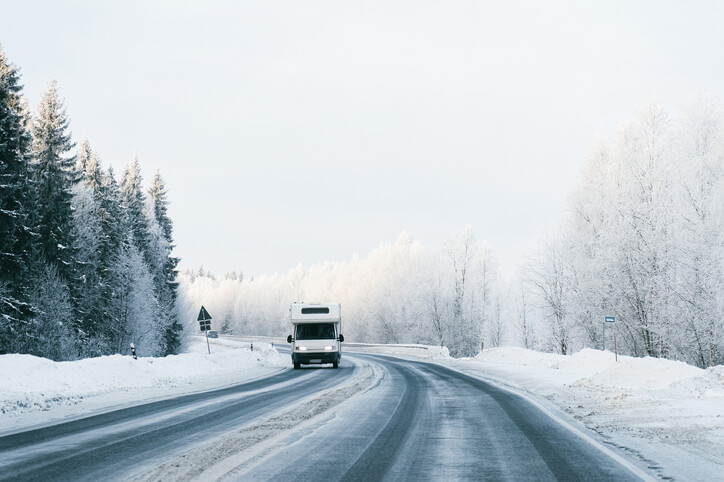Gone with the Snow: 4 Necessities for Winter RVing
Contents
Vacationing in your RV is often synonymous with summer. Think about it! Memories of family vacation might include trips to the beach, educational sightseeing, and exhilarating theme parks. As a method of vacationing, RVing is also associated with fun in the sun–hiking, swimming, fishing, and campfires are all found at RV destinations across the country.

Now…what about winter RVing? Does cold weather mean the end of vacations? Some may think so. But thousands of adventurers each year would beg to differ. After all, with a motorhome or trailer to keep warm, the destination possibilities are limitless. Skiing, snowboarding, snowshoeing, and landscape photography are just a few ways cold-weather enthusiasts are enjoying their winter vacations.
Prepare Your RV
Having decided upon a winter trek, you need to carefully prepare your RV. Without taking the appropriate measures before leaving the driveway, you’re setting yourself up for an unpleasant experience. There are four distinct factors that any future winter RVer should consider:
1) Skirting
Without proper insulating, and winterizing your RV is left exposed to the extreme winter weather. Many winter RVers tend to invest in high quality skirting around the base of their RV, and in more permanent situations, even framing and insulation. Assuming your winter adventure is fairly brief (a couple weeks), we recommend contacting a skirting specialist. Online resources provide consumer reviews and opinions from other RVers.
Once you have the protective skirting in place, an electric space heater can be used to warm the cavity. Due to a potential fire hazard, we advise that you avoid propane heaters. Heat is our goal, but not quite at that level.
2) Warm Plumbing
Good news for all creatures of comfort out there: it is possible to keep your plumbing running smoothly! No need to stagger to the outhouse in a blizzard. There are just a few more simple steps to help keep your septic system up and running in winter as opposed to summer. It’s not hard! The key is in keeping your pipes warm so that they don’t freeze and crack. This can be accomplished by installing tank heaters in your tanks, and finding a small AC heater to install inside your sewer and water compartments. Using fans to keep up the warm air flow around the pipes will be enough to keep it from freezing.
3) Internal Condensation Solution
During the winter one of the issues that many RV’s are forced to deal with is condensation. It builds up on the windows, pools in the window sills, and makes the cupboard doors stick together. Yuck. Installing a dehumidifier in your RV a few days before take-off cuts down on the amount of condensation inside. Another big help is having double panelled windows. This helps to keep the heat in, and reduces the possibility of any water seeping in through the window. Double check all the seals as well. Door seals, window seals, etc, and replace any if necessary. This will help to keep you snug and warm, and prevent any drafts that will aggravate the condensation problem. With these simple precautions, you’ll be able to ride high and dry!
4) Carbon Monoxide Detector
One of the great risks of wintering in your RV is the possibility of Carbon Monoxide poisoning. This is much more of a frequent danger than most people might think. If any of your heating facilities (stove, heaters, lanterns, etc.) heat using a flame of any kind, you need to install a carbon monoxide detector. The CO fumes will gather in small spaces without a lot of airflow, and are often deadly to humans and animals alike.
At this point you’re probably changing your mind about the whole idea of wintering in your RV. Possibility of death is no vacation, you’re thinking. Well, don’t worry. While it is vital to be aware of the danger, there are ways for you to take the necessary precautions, and then go and have a great time. Simply install a good quality CO detector. There are websites galore that will offer you all the information you could possibly want on the topic. So brush up on your poison control, buy a detector, stick it in the wall, open a window every once in a while, and you’re good to go!
So once you’ve chosen your destination, double check this list of necessary preparation, pull on your boots, and you’re ready to roll! Give Jack Frost our greetings!

